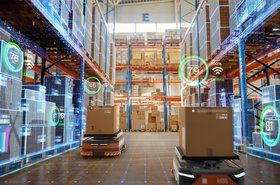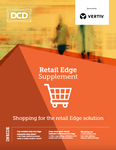The retail world has fundamentally changed. Mail order catalogs and massive shopping malls are no longer the only places to shop and ‘digital’ and ‘omnichannel’ are the new names of the game.
Consumers have more options than ever before and their expectations have risen accordingly – from fast shipping and easy returns to buy online, pick-up in store, to the desire for a seamless in-store and online experience. In fact, according to a 2021 survey, 65 percent of consumers want the ability to scan items in a store to see product details on their phone, and half expect contactless payment options. One-fifth want to be able to try on clothes using ‘virtual mirrors’ that rely on augmented reality.
As I discussed in my recent DCD webinar on retail edge computing, no matter the retail space – whether a restaurant, a big box store, or a mom-and-pop shop’s storefront – these applications increasingly rely on edge computing. While retailers almost uniformly depend on the edge, the resources needed differ depending on the environment.
Vertiv’s report, Edge Archetypes 2.0: Deployment-Ready Edge Infrastructure Models, can provide a helpful framework to better design the critical infrastructure needed for the edge network for retail.
Big box superstores micro Edge supported by micro data centers
Big box superstores exploded in popularity during the pandemic, emerging as one-stop-shops for groceries and household essentials. The US warehouse and superstore industry, which includes about a dozen companies encompassing 8,200 stores, boasts a combined annual revenue of about $550 billion, with some of the biggest and most recognizable brands in the world.
Superstores have developed their IT infrastructure to put the customer at the center, enabling curb-side pickup, in-store apps, mobile coupons, and even technologies to track consumer behavior.
Many superstores rely on the ‘micro Edge’ to support these applications: small, standalone solutions that range in size from one or two servers up to four racks. Each store location might have their own on-site IT infrastructure to reduce latency and provide the storage needed to collect and use customer data.
At the micro Edge, an outage can have a major impact, not only on customer loyalty but on the company’s bottom line. Superstores need a robust IT infrastructure to prevent outages, including uninterruptible power supply (UPS) systems for backup power, racks for physical security of servers, and thermal management systems to keep those servers cool.
Integrated modular solutions provide physical security for IT equipment, dedicated cooling systems, UPS systems for power conditioning and protection, and rack power distribution units (rPDUs). These can be as small as a single cabinet or as large as an integrated row, aisle, or containerized solution, offering flexibility to meet the needs of the micro data centers.
Critical digital infrastructure models for retail distribution centers
Every time you click ‘add to cart,’ your order is likely fulfilled through a retail distribution center. Distribution centers are the linchpin of a multi-channel approach to customer service and fulfillment. Construction on new distribution centers reached new highs in 2021, growth that’s expected to continue.
If you look past the bright lights and tall ceilings, you’ll see these aren’t just any warehouse. Edge computing systems manage inventory and logistics, use AI technology to bridge gaps created by ongoing labor shortages, and manage demand from customers around the world.
As we outline in our report on edge infrastructure models, distribution centers rely on infrastructure both large and small, including a distributed Edge data center, to provide the compute needed to keep critical IT functions running across a large space. Warehouses also may deploy at the Device Edge, where the compute resides at or even in the end device. In this case, the IT hardware may be fully enclosed within pieces of equipment in the warehouse. These smart devices allow data to be collected and transmitted on pieces of machinery within the warehouse to optimize operations and provide visibility.
The physical environment of a warehouse isn’t particularly IT-friendly. It is often dusty and hot, and although they are full of people, IT staff usually aren’t among them. To help withstand the high temperatures, UPS systems can provide clean power and backup power to IT systems. A small UPS system with lithium-ion batteries can operate at high temperatures and is smaller than a system with traditional batteries, making it ideal for distribution centers. Cooling solutions deliver clean, cold air straight to the rack or row to prevent server failure and ensure the computing systems stay up and running.
Since IT support isn’t on site in a distribution center, remote visibility and control is key. With comprehensive monitoring and management, you can ensure efficient operations and identify issues before they arise.
Both superstores and distribution centers are also often supported with a distributed Edge data center. This is a small, sub-20 rack data center, situated at a dedicated facility close to the locations that can filter and aggregate data from across sites, sending only the necessary information to the cloud. The largest retailers may also rely on a regional Edge data center – typically a multi-tenant data center with more than 20 racks, purpose-built to host compute infrastructure.
As we discuss in the new DCD Retail Supplement, we’re also seeing these trends in restaurants and grocery stores, which have their own unique challenges and opportunities. Regardless of the type of environment, one thing is certain: technological advancements in retail will continue at a rapid pace. Making sure your edge infrastructure is equipped to keep up doesn’t have to be a headache. Our team at Vertiv can recommend solutions based on your unique needs to help you meet today’s demands and prepare for future growth and evolution at the edge.
To learn more about the challenges and solutions at the retail edge, including best practices to enhance the customer experience, download “Optimizing Your Retail Edge.” [PDF]
More...
-

Sponsored A chilled approach to sustainability
How chilled water cooling can play a part in unlocking sustainable data center growth
-

Energy at the retail Edge
If retail becomes more digitized, will that break the energy bank? Maybe not, if stores share energy with the grid, and Edge devices learn to power themselves
-

Can retailers buy the Edge networks they want?
The retail industry can be demanding customers. Are the Edge network providers ready to satisfy their needs?




